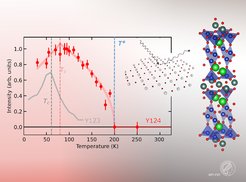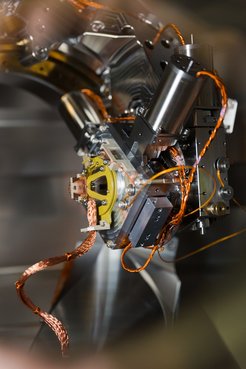Unveiling the relationship between charge order and the pseudogap in a homogeneous high-temperature superconductor
Our team at the Max Planck Institute for Solid State Research, in collaboration with the European Synchrotron Radiation Facility (ESRF) and the Karlsruhe Institute of Technology, has uncovered a fundamental link between charge order and the pseudogap phase in the stoichiometric cuprate superconductor YBa2Cu4O8 (Y124).

Despite decades of intensive research, the underlying mechanism of high-Tc superconductivity in cuprates remains an open question. One strategy to address this challenge is to investigate the normal state from which superconductivity emerges. Charge order, characterized by spatially periodic modulations of electronic charge density, is a universal feature of the cuprates’ normal state. Energy-resolved resonant x-ray scattering (RXS) is a powerful tool for probing this phase, as it provides direct access to the truly elastic scattering signal from the charge modulation as well as a Fourier-space representation of the charge distribution. In RXS experiments, charge order manifests itself as peaks in momentum space, with their position, width, and intensity revealing key properties such as periodicity, correlation length, and modulation amplitude.

We have used the ERIXS spectrometer at the ID32 beamline of the ESRF and its unique 4-circle in vacuum goniometer, which enables both cryogenic cooling and precise manipulation of small samples, to perform RXS on single crystals of Y124 smaller than 500 μm. We demonstrate that charge order in Y124 emerges as a genuine phase transition at T = 200 K, coinciding precisely with the onset of the pseudogap T* as previously determined by other spectroscopic studies. This finding, made possible by studying a system largely free from chemical defects, suggests that disorder due to chemical substitution causes a gradual onset of charge order correlations rather than a sharp transition in other cuprates, such as YBa2Cu3O6+x (Y123).
Our results thus challenge the accepted view that the pseudogap and charge order are independent phenomena and establish a direct experimental foundation for their connection. By providing a clean-system benchmark, this study enhances our understanding of high-temperature superconductivity and highlights the critical role of disorder in shaping the cuprate phase diagram.
This work also paves the way for future investigations into how external parameters, such as strain or magnetic fields, modulate charge order and its interplay with superconductivity in the Y124 system and other quantum materials.













